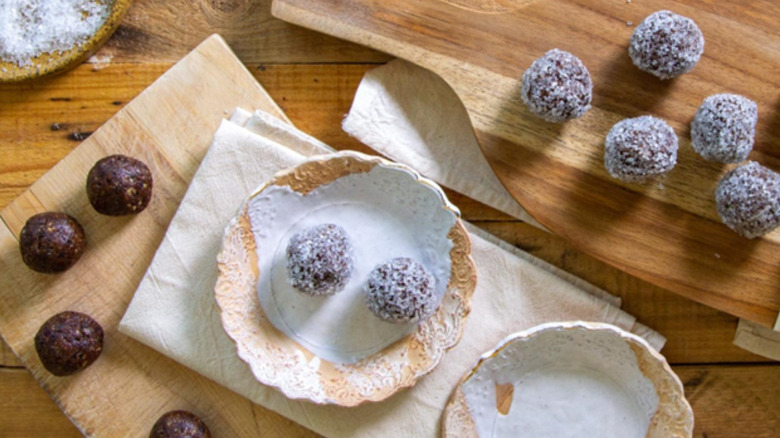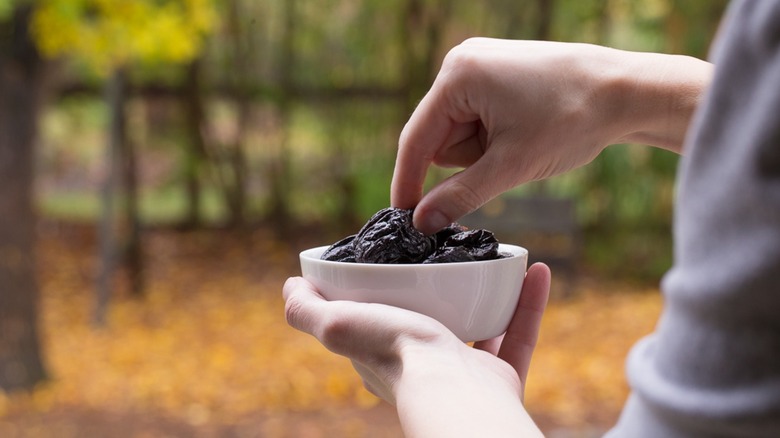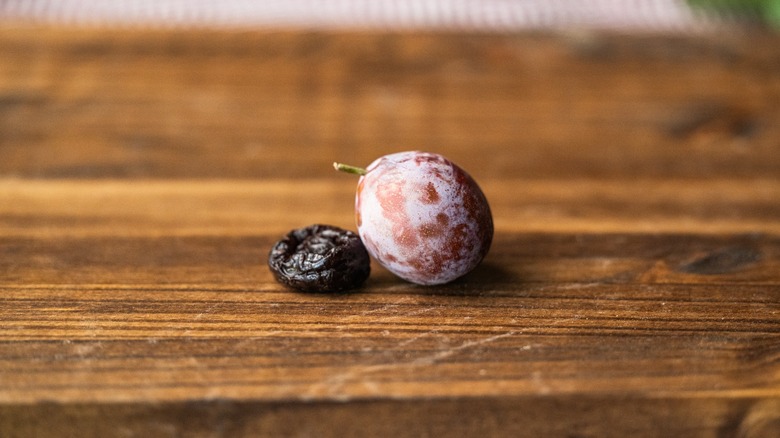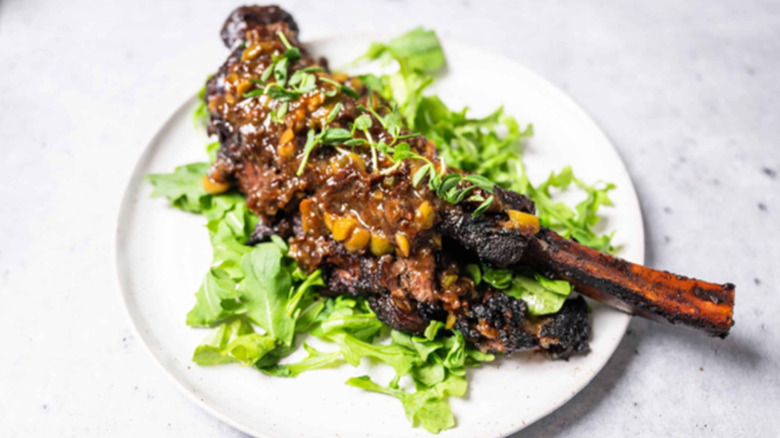The Newstalgic Superfruit: California Prunes, A Curated Classic For Today's Table
Sponsored Content. We may receive a commission on purchases made from links.
As cooks bring vintage concepts into the modern limelight to develop their own signature cooking styles, they look to "newstalgic" ingredients with time-tested quality but enough flexibility to evolve a myriad of recipes. If you're looking for a versatile ingredient to experiment with, look no further than California prunes. This superfruit provides both comprehensive nutrition and that warm comfort only found with reliably high-quality food.
Though many viral ingredients come and go, prunes have maintained their status as an in-demand food for over a century because they're surprisingly delicious and naturally good for you. Though historically popular as a simple snack, prunes are as complex and gratifying an ingredient as any other modern creation. Rich with intricate natural sugars, jammy textures, and a subtle but undeniable umami sensation, their re-entry into the 21st-century culinary spotlight is long overdue.
From seeking out the advice of a nonna for the perfect homemade pasta to deep dives into centuries-old kimchi fermentation techniques, people crave a return to the basics that inspired the last century's wealth of culinary innovation. Whether you're looking to adopt old-school practices or adapt them into your own modern twist, there are few better ingredients to use than the delicious, nutritious, and always versatile California prunes.
Old-school techniques, 21st-century twists
Thanks to their all-natural sweetness, full-bodied flavor, and soft but chewy texture, prunes are a versatile ingredient. It doesn't matter if you're craving sweet or savory, rich or light, baked or braised dishes — the California prune will deliver. Whether you have visions of sugar plums dancing in your head or an insatiable craving for a savory Moroccan tagine, prunes provide complexity and balance to a dish in a way that's always noticeable and never overpowering.
In older times, when folks either rationed or didn't have reliable access to sugar, they leaned on the natural sweetness of prunes. Recipes like old-fashioned prune cakes provided the luxury of a satisfied sweet tooth without needing much added sugar, all while capitalizing on the fruit's caramel tasting notes to create a complex, delicious dessert. This scarcity drove innovation and created a demand for prunes as a sugar substitute that persists to this day.
As old-school techniques collided with modern palates, celebrated chefs like New Orleans' own Bronwen Wyatt took to the challenge of giving prunes the place they deserved in the world of desserts. She transformedprune whip, a dessert relegated to 1950s sensibilities, into a cross-century marvel. Relying on prunes' red wine notes, she paired them with a long simmer in Armagnac before folding them into soft mascarpone with salt and vanilla until she had a beautifully whipped dessert as good as any soft serve. Much like theflaky apple, phyllo, and prune tart from the Toulouse region of France, a cook's reimagining of what prunes can do for classic dishes always creates incredible flavor and undeniable quality.
Prunes are the ultimate superfruit
While most people think of prunes as a digestive aid to promote regularity and a healthy gut biome, they're a far more nutrient-dense option than that. Although studies show that fiber in dried plums and the mild laxative function of prune juice promote stomach health, everything from their chronic disease-limiting phenolic (plant-derived) compounds to a single serving's bone-strengthening boron makes them as comprehensive a superfood as you could hope to find.
As recently as 2022, there has been no shortage of researchers looking into the bone density benefits of prunes. They provide both Vitamin K and naturally occurring polyphenols known to prevent inflammation-caused bone density loss that may lead to osteoporosis. A study published in Osteoporosis International found that eating just four to six prunes a day helped maintain a healthy bone density in post-menopausal women. While these compounds may be found in other foods and supplement combinations, the unique composition of nutrients found in prunes makes them an easy and delicious way for families to get their daily fruit intake.
The same randomized control trials measuring the health benefits of two servings of prunes also found healthy biomarkers related to reduced inflammation, improved cardiovascular health, and immune function. Additionally, prunes contain sorbitol and fructose, which are lauded for not spiking blood sugar levels and maintaining healthy gut flora.
Prunes are rooted in California
In 1850, the long history of California prunes began when French grower, Louis Pellier, founded Pellier's Gardens, grafting a celebrated d'Argen prune sampling onto local trees. Over time, this eventually developed into the California prune, a variety so widely demanded it eventually overtook the entire American market.
By 1908, The Dried Fruit Association of California formed to oversee the handling of growing, transportation, and contracts, providing much-needed stability for organizing labor and inventory. Though it eliminated some eccentric forms of innovation such as employing 500 monkeys as pickers, it kick-started some much-needed innovation to position prunes in the minds of consumers as a high-quality ingredient and source of nutrients. Prunes even replaced much of the California hops and grapes market following Prohibition, providing employment and even a taste of home and comfort to WWII and Korean War soldiers.
Whether you know it as Santa Clara Valley,The Valley of Heart's Delight, or Silicon Valley, this region of California was one of the most important segments of the global fruit market through the 1960s. Though the technological innovations around prune production attracted the same companies that would later shift production to the Sacramento Valley, an explosion in demand promoted a new age of health-conscious marketing that all began in California's Prune Belt.
Modern creativity for a timeless classic
A far cry from the shelf-stable essential of pantries centuries ago, California prunes' recent return to the limelight creates a new age of experimentation. The unparalleled access modern chefs have to recipes and techniques from around the world has fused different cultures into an addictively delectable whole.
Though most still think of prunes as a way to boost desserts like boxed brownie mix, the fruit's umami combined with its complex flavor profile make it equally good for elevating classic meat dishes. "Top Chef" finalist Stephanie Cmar employs a prune-infused barbecue sauce to take her beef ribs to the next level, creating a velvet-smooth braising liquid that later caramelizes into a smoky, fruit-forward glaze. Similarly, a classic dish from the '80s, Chicken Marbella, relies on prunes' sugars to cut the saltiness of its other main ingredients: capers and olives. Modern vegan varieties that substitute the chicken with potatoes benefit from prunes just as much, creating a starchy, modern nod to a nostalgic entree with the same delicate balance of salt, sugar, and acid.
For vegetables, the natural umami in prunes provides that deep level of satisfaction after a meal that's hard to find elsewhere. Chef and James Beard Award winner Gregory Gourdet simmers chopped prunes with ingredients like tomatoes, olives, and chili flakes to toproasted cauliflower, infusing each bite with heartiness and diluting sharpness from spicy or acidic ingredients. As a staple of ancient diets recently elevated by the sheer excellence of modern growing practices,California prunes have stood the test of time and continue to provide a variety of health benefits in a sweet and wholesome package.





